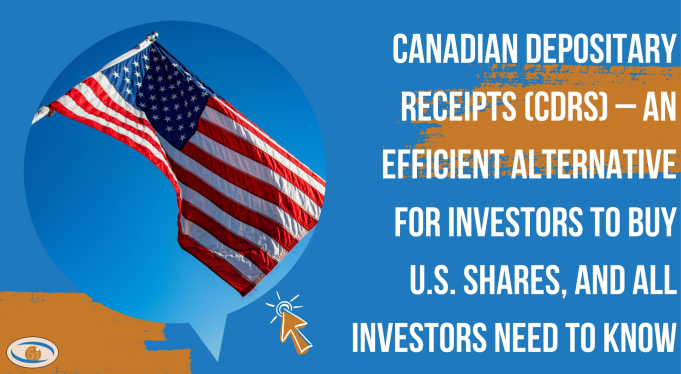Canadian Depositary Receipts (CDRs) are a relatively new concept that has been introduced in recent years to help Canadians gain access to U.S. blue-chip stocks in a simplified, low-cost manner. Many investors have questions about the mechanics and certain pros and cons of holding CDRs in the portfolio. This blog will help address those concerns:
1. All about Canadian Depositary Receipts (CDRs).
Canadian Depositary Receipts (CDRs) are securities that trade on the NEO Exchange in Canada, and the concepts are essentially similar to American Depository Receipts (ADRs) that are listed on American exchanges. CDRs give Canadians access to some of the largest US companies listed on NYSE and NASDAQ through a Canadian exchange in Canadian dollars. CDRs are issued and managed by the Canadian Imperial Bank of Commerce (CIBC). There are no management fees, so the main cost that investors will incur is the buy/sell commission on trades.
2. Pros/Cons.
PROS:
Accessibility in registered accounts: CDRs can be held within registered accounts, similar to other Canadian-listed securities. We think CDRs can fit in any account, but generally, growth investments are usually better in a TFSA.
Currency-hedge feature: There is a currency-hedge built into the shares. That said, the built-in currency hedge has a certain cost and may not perfectly track changes in track exchange rate. There are no management fees associated with CDRs, but CIBC does make money on the currency hedge. While investors do not see this as a charge, it does impact net asset value. This cost is estimated to be about 0.50% annually.
The benefit of currency hedging could be explained through this example. For instance, if the Canadian dollar strengthens relative to the US dollar, then the CDR will appreciate more than the US equivalent, and vice versa, if the US dollar appreciates, the CDR will lag the US equivalent. As investors might expect, this is simply a currency call.
Fractional ownership: One of the key advantages of CDRs is a lower share price. CDRs are structured so that the price per share always starts at $20, giving a wider array of investors access to these global companies. In simple terms, CDRs represent fractional interest in the underlying US shares.
CONS:
Illiquidity: The primary disadvantage of owning CDRs is their lower liquidity than the US shares. Consequently, a wider bid-ask spread could result in a higher cost when buying/selling for investors.
Withholding taxes still apply: Despite trading on Canadian exchanges, the underlying assets are still U.S. shares, which are subject to withholding taxes for dividends received (except in an RRSP account).
Limited selection: Since the product is still new, only a handful of well-known U.S. mega-cap stocks are currently available. Most small- and mid-cap U.S. companies are not yet offered as CDRs.
Conclusion
Overall, we are comfortable with CDRs for investors who want lower-priced exposure to U.S. securities with a built-in Canadian hedge. They are not fundamentally different from owning the underlying shares, aside from their price, the currency hedge, and where they trade. The underlying U.S. shares are held by CIBC, which issues the CDRs.
We generally prefer non-hedged products and would favour owning the U.S. shares directly if investors have the capital available and are comfortable with currency exposure. That said, we view CDRs as a good complementary option within a portfolio, and we would be comfortable buying them for U.S. company exposure.
Unlock the Power of Informed Investing with 5i Research!
DIY investing doesn't have to mean going it alone. At 5i Research, we're your trusted partner in navigating the stock market. Our platform offers comprehensive stock and market research, empowering you to make smart investment decisions.
- Investor Q&A: Have burning questions? Get answers from our team of experts and fellow investors in our dedicated Q&A section.
- Research Reports: With over 60 meticulously researched Canadian stocks, our reports offer in-depth analysis, giving you the confidence to invest wisely.
- Model Portfolios, Alerts, Forums, Portfolio Tracking, and Much More...
Take Care,

Disclosure: The analyst(s) responsible for this report do not have a financial or other interest in the securities mentioned.






Comments
Login to post a comment.